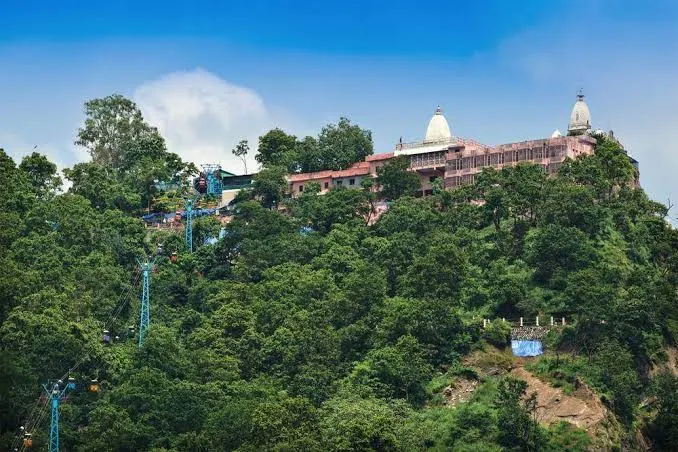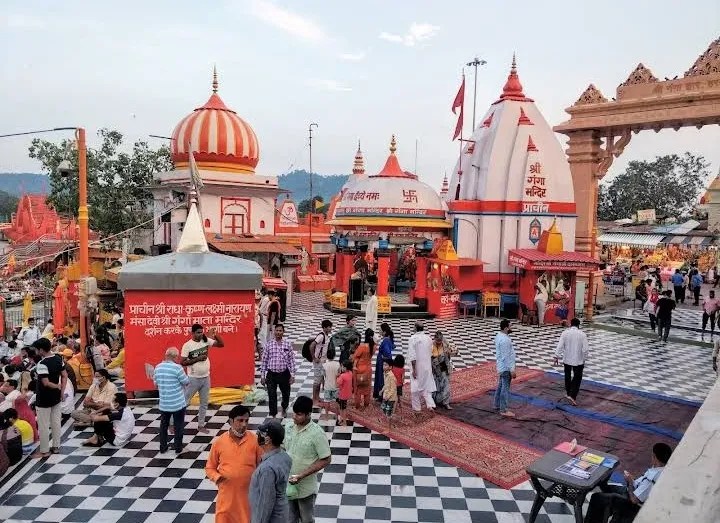There are few places in India that embody spirituality quite like Haridwar. Nestled on the banks of the holy Ganga River and cradled by the Shivalik Hills, this ancient city pulses with the chants of mantras, the clang of temple bells, and the vibrant energy of faith. Among its many spiritual landmarks, the Mansa Devi Temple stands tall—both literally and figuratively—as a beacon of devotion. A journey to this revered shrine is not just a temple visit; it is an experience of soul-stirring connection, scenic beauty, and cultural depth.
In this travel blog, we’ll take you through every step of the journey—from reaching Haridwar, ascending to the hilltop temple, understanding the mythology behind Mansa Devi, and immersing in the divinity that surrounds it.
The Legend of Goddess Mansa Devi
Before beginning the climb, it’s essential to understand why Mansa Devi is so revered. According to Hindu mythology, Goddess Mansa is believed to be a form of Shakti and the daughter of Sage Kashyap. The word ‘Mansa’ translates to ‘wish,’ and true to her name, the goddess is known to fulfill the heartfelt desires of her devotees.
Pilgrims often tie threads to the sacred tree inside the temple as a symbolic representation of their wishes. Once their prayers are fulfilled, they return to untie the thread, completing a cycle of faith and gratitude.
Want to know more, check out this link by Shri Mata Mansa Devi Shrine Board.
Getting to Haridwar: The Gateway to the Gods
Haridwar is well-connected by road, rail, and air. The city has its own railway station with frequent trains from Delhi, Dehradun, and major northern cities. If you prefer to drive, a road trip from Delhi via NH334 is scenic and takes about 5-6 hours depending on traffic.
The nearest airport is Jolly Grant Airport in Dehradun, about 40 km away, and taxis or buses are easily available for onward travel to Haridwar.
Once in the city, the presence of temples, ghats, and religious fervor is almost immediate. Rickshaws, autos, and even shared tuk-tuks make navigating the town easy, albeit a bit chaotic during peak seasons.

The Spiritual Vibe of Haridwar
Haridwar is not just a city—it’s an emotion. With saffron-clad sadhus, the aroma of incense, and the Ganga Aarti at Har Ki Pauri, every corner resonates with devotion. A visit to Mansa Devi is often combined with other temple tours, dips in the Ganges, and evening aartis. But Mansa Devi holds a special place, both as a Shaktipeeth and as one of the Siddh Peeths (power spots) in Northern India.
Reaching the Mansa Devi Temple: Trek or Take the Ropeway
Mansa Devi Temple is perched atop Bilwa Parvat, part of the Shivalik Hills. You have two ways to reach the top:
1. The Ropeway (Udan Khatola)
If you want a comfortable, panoramic ride to the top, the ropeway is ideal. Known locally as Udan Khatola, this cable car offers breathtaking views of Haridwar city and the Ganga snaking through it. Especially during the golden hours of sunrise or sunset, the view is nothing short of magical.
The ride is around 5 minutes long, and tickets are available at the base station. During holidays or yatra seasons, queues can be long, so booking early in the day is recommended.
2. Trekking Up the Hill
For those who enjoy a bit of a spiritual trek, a stone-paved trail of around 1.5 kilometers winds through the forest to the temple. It’s steep in parts, with vendors selling coconut, flowers, and prasad along the way. The path is shaded by trees, and the climb takes about 30–45 minutes depending on your pace.
Many pilgrims prefer to walk barefoot as a mark of respect, so watch your step and carry water if you choose this route.
The Temple Complex: A Peaceful Pilgrimage
Once you reach the top, the temple complex greets you with colorful flags, intricate architecture, and a panoramic view of Haridwar town below. The temple itself is not very large, but the energy inside is palpable.
The main sanctum houses the idol of Goddess Mansa, adorned with flowers and gold ornaments. Priests offer prasad, apply tilak, and bless you with holy water. Behind the temple is the famed Kalpavriksha—the sacred wish-fulfilling tree where devotees tie sacred threads.
The view from the temple is simply unforgettable. You can see the vast Ganga plains, the bustling Haridwar town, and even the green hills of Rishikesh in the distance.
Temple Rituals and Timings
- Timings: The temple is open daily from 5:00 AM to 9:00 PM, with a short break in the afternoon.
- Aarti: Attending the morning or evening aarti at Mansa Devi is a soul-cleansing experience. Devotees chant hymns, conches blow, and bells ring in synchrony, enveloping you in divine sound.
- Navratri Special: During Navratri, the temple attracts thousands of pilgrims and is beautifully decorated with lights and garlands. The energy during this time is electrifying.
Combining Your Visit: Mansa Devi and Chandi Devi
No visit to Mansa Devi is complete without also paying respects at Chandi Devi Temple, located on Neel Parvat, on the opposite side of the city. It’s also reachable by ropeway or foot. Together, Mansa Devi and Chandi Devi form a divine duo that completes a traditional pilgrimage in Haridwar.
Some devotees also include a visit to Maya Devi Temple, making it a tri-temple spiritual tour known as the Trikona Parikrama.
Shopping and Local Experiences
On your way back from the temple or while strolling near Har Ki Pauri, indulge in some local shopping. You’ll find:
- Rudraksha malas
- Copper and brass puja items
- Sacred Ganga Jal in sealed bottles
- Kumkum, bangles, and vermilion
- Postcards and souvenirs with Hindu deities
Don’t miss the sweet shops that serve piping hot jalebis, kachaudis, and rabri—perfect after a long walk or spiritual retreat.
Best Time to Visit Mansa Devi
- Autumn-Winter (October to March): This is the best time to visit. The weather is pleasant, making the climb or ropeway ride comfortable.
- Navratri: Twice a year (Chaitra and Sharad Navratri), the temple sees a surge of devotees. The celebrations are grand, though it gets crowded.
- Avoid Monsoon: The hills get slippery, and ropeway services may be affected by rain and wind.
Travel Tips for Devotees and Visitors
- Footwear: If you’re trekking, wear good sandals or shoes. Many leave their footwear at the base as a devotional practice.
- Water and Snacks: Carry your own bottle. Vendors are available but prices can be high during peak times.
- Camera Policy: Photography inside the sanctum is generally prohibited. Outside, feel free to click stunning panoramic shots.
- Keep Change Handy: For prasad, donations, and tips to helpers.
- Senior Citizens: Prefer the ropeway as the climb may be physically taxing.
Where to Stay in Haridwar
Haridwar has a wide range of accommodation options—from dharamshalas and budget lodges to luxury hotels and riverside resorts. If you’re looking for a spiritual retreat, consider staying near Har Ki Pauri or the ghats. Some well-maintained ashrams also offer stays, providing both meals and a peaceful ambiance.
Recommended areas to stay:
- Upper Road / Har Ki Pauri zone: Close to the temple ropeways and the Ganga Aarti
- Jwalapur: For budget options
- Rishikesh Road: A bit away from the crowds but very scenic
A Moment of Stillness
After completing your darshan at Mansa Devi, take a moment to just sit at the hilltop. Let the wind brush your face, listen to the distant chants, and look at the mighty Ganga below. Whether or not you came with a wish, you’ll feel a sense of peace settle into your being.
This is what makes the visit to Mansa Devi Temple so profound—it’s not just about asking for blessings, but about feeling blessed by the journey itself.
Conclusion: Where Faith Meets the Mountains
Mansa Devi Temple is more than a place of worship. It is an experience of devotion, discipline, and discovery. It invites you to pause, pray, and reflect. The journey, whether on foot or by cable car, is not just a physical one—it’s emotional and spiritual.
If you’re seeking blessings, hope, or simply a connection to something larger than yourself, then make your way to the divine hilltop of Mansa Devi. And when you return, you’ll carry more than just prasad or photos—you’ll carry the peace of the mountains and the memory of faith fulfilled.
Let the bells ring, the wishes rise, and the soul ascend. Welcome to Mansa Devi.
My Other Posts
If you are looking for options in Kashmir, check out my posts on Pahalgam, Gulmarg, Snowfall in Kashmir, and Best Time to Visit Kashmir. If you are looking for options in Ladakh, check out Ladakh Weather, Nubra Valley, 5 Days Kashmir Itinerary, Best Packing tips for Ladakh & best tourist places in Ladakh.
If you are looking for something in Sikkim, check Tsomgo Lake, Nathu La Pass, Baba Harbhajan Singh Mandir and Batasia Loop. If you are looking for some jungle safari read Gir Safari, or Bandipur Safari, feel blessed at Sri Venugopala Swamy Temple in Mysore.
If you are looking for places to visit in the Andaman Islands, please check my posts on Radhanagar Beach & Ross Island.
If you are looking for other options, check my posts on Murud Janjira, Kashid, Pirwadi Beach and Kihim Beach in Maharashtra or Malshej Ghat, Matheran Resorts, Kailash Temple Ellora, Vandri Lake, Kelwa Beach in Palghar & Mahabaleshwar.
Alternatively, if you are interested in some Religious tourism, please check my posts on Golden Temple, Kamakhya, Trimbakeshwar, Somnath Temple, Kalighat Temple, Dakshineswar Temple and Kashi Vishwanath. If you are looking for North East Adventure tours, check my posts on Shillong, Meghalaya, Dawki, Double Decker Living Root Trek, and 7-Day North East Itinerary

